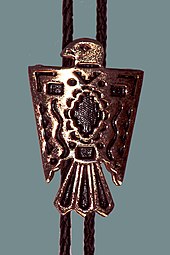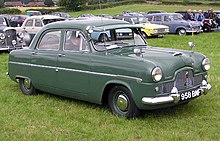Teddy Boys
The Teddy Boys or Teds were a mainly British youth subculture of the early 1950s to mid-1960s who were interested in rock and roll and R&B music, wearing clothes partly inspired by the styles worn by dandies in the Edwardian period, which Savile Row tailors had attempted to re-introduce in Britain after the Second World War.In post-war Britain, rationing continued to affect the fashion industry until it ended in 1949 and men's tailors in central London devised a style based on Edwardian clothing hoping to sell to young officers being demobilized from the services.[7] However, the style—featuring tapered trousers, long jackets similar to post-war American zoot suits, and fancy waistcoats—was not popular with its target market, leaving tailors with piles of unsold clothing which, to recoup losses, were sold cheaply to menswear shops elsewhere in London.The 1953 film Cosh Boy (US: The Slasher), written by Lewis Gilbert and Vernon Harris, makes an early reference to the style when the character, Roy (James Kenny), speaks the words "[it's a] drape...the latest cut".[3] Teddy Boy clothing included drape jackets reminiscent of 1940s American zoot suits worn by members of Italian-American, Chicano and African-American communities (such as Cab Calloway or Louis Jordan), usually in dark shades, sometimes with a velvet trim collar and pocket flaps, and high-waist "drainpipe" trousers, often exposing the socks.Although not as big as the Americans, British rock and roll artists such as Tommy Steele, Marty Wilde, Cliff Richard, Dickie Pride, and Joe Brown became popular with the Teddy Boy culture, as did the Merseybeat scene in the early 60s.[1] Following The London Rock and Roll Show held at Wembley Stadium in August 1972 (featuring American performers including Little Richard, Jerry Lee Lewis, Chuck Berry, and Bill Haley, plus UK-based support acts),[29][30] the music enjoyed a renewed period of popularity.[32] The new generation of Teds adopted some aspects of the 1950s but with a large glam rock influence, including louder colours for drape jackets, brothel creepers, and socks and shiny satin shirts worn with bootlace ties, jeans and big-buckled belts.







Teddy Boy (disambiguation)Britishyouth subculturerock and rolldandiesEdwardian periodSavile RowSecond World WarcreepersLondonWorld War IIEdwardian-era fashionDaily ExpressTerritorial ArmyThe Swoop!P. G. WodehouseEdward VIIrationingzoot suitswaistcoatsCosh BoyLewis GilbertVernon HarrisscuttlersLiverpoolManchesterBlackboard JungleElephant and Castle1958 Notting Hill race riotsWest IndianSt Ann's riotsNottinghamLes Grayglam rockdrainpipe trousersdrape jacketsItalian-AmericanChicanoAfrican-AmericanCab CallowayLouis Jordan"drainpipe" trousersBilly Eckstinebolo tiebrocadewaistcoattailorOxfordsbroguesbrothel creepersduck's arsepencil skirtshobble skirtsboaterespadrillescoolie hatstrouserscircle skirtsponytailstrademark clothesKen RussellPicture PostLiz HamOysterBill Haleythe Cometstartanjump bluesskiffleKen MackintoshElvis PresleyEddie CochranBritish rock and rollTommy SteeleMarty WildeCliff RichardDickie PrideJoe BrownMerseybeatGeorge HarrisonJohn LennonBilly FuryShakin' StevensThe London Rock and Roll ShowWembley StadiumLittle RichardJerry Lee LewisChuck BerryAmerican GraffitiThat'll Be the DayWizzardThe Glitter BandShowaddywaddyVivienne WestwoodMalcolm McLarenKing's Roadbootlace tiespompadourSex PistolsFord ZephyrTottenhamnorth LondonBruce WeberAnthony BurgessA Clockwork OrangeNowhere BoyBeatnikBodgies and widgiesGreasersMods and rockersNed (Scottish)RaggareRocker (subculture)StilyagiThe GuardianThe ObserverThe IndependentWayback Machine